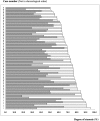Angioplasty and stenting of intracranial atherosclerosis with the Wingspan system: 1-year clinical and radiological outcome in a single Asian center
- PMID: 23512176
- PMCID: PMC3933179
- DOI: 10.1136/neurintsurg-2012-010608
Angioplasty and stenting of intracranial atherosclerosis with the Wingspan system: 1-year clinical and radiological outcome in a single Asian center
Abstract
Background: This study aimed to evaluate the 1-year clinical and angiographic outcome of angioplasty and stenting of intracranial atherosclerosis using Wingspan and Gateway system.
Methods: In this prospective study, patients with symptomatic lesions were treated and followed clinically and angiographically by digital subtraction angiography (DSA) for 1 year. The two primary endpoints were recurrent ipsilateral ischemic stroke and in-stent restenosis (ISR) at 1 year. Secondary endpoints included periprocedural death or stroke and all strokes at 1 year. Potential factors correlated with ISR were studied using univariate and multivariate analysis.
Results: Treatment was attempted in 65 patients and successfully completed in 61 (93.8%). Fifty-nine patients (44 men, 15 women) aged 62.86 ± 11.38 years with 66 stenoses (average degree of stenosis 71.78 ± 11.23%) underwent clinical and DSA follow-up at 1 year. There were 66 stenotic lesions. ISR occurred in 11 of the 66 lesions (16.7%). Luminal gain occurred in 32 of the lesions (48.5%), an unchanged lumen in 4 (6%) and luminal loss in 30 (45.4%). The periprocedural stroke or death rate was 6.1% (4/65), including three hemorrhagic and one ischemic stroke, all of which occurred at the corresponding site and resulted in death. There were no interval strokes between the periprocedural time and the 1-year follow-up. The occurrence of ISR was correlated with the degree of stenosis before treatment and was not correlated with patient age or sex, vessel diameter, location of stenosis or failure to control risk factors for atherosclerosis.
Conclusions: One-year clinical and angiographic outcomes of angioplasty and stenting are promising for symptomatic intracranial atherosclerosis.
Keywords: Angioplasty; Atherosclerosis; Intervention; Stenosis; Stent.
Figures



References
-
- Sacco RL, Kargman DE, Gu Q, et al. Race-ethnicity and determinants of intracranial atherosclerotic cerebral infarction. The Northern Manhattan Stroke Study. Stroke 1995;26:14–20 - PubMed
-
- Broderick J, Brott T, Kothari R, et al. The Greater Cincinnati/Northern Kentucky Stroke Study: preliminary first-ever and total incidence rates of stroke among blacks. Stroke 1998;29:415–21 - PubMed
-
- Wong KS, Huang YN, Gao S, et al. Intracranial stenosis in Chinese patients with acute stroke. Neurology 1998;50:812–13 - PubMed
-
- Bose A, Hartmann M, Henkes H, et al. A novel, self-expanding, nitinol stent in medically refractory intracranial atherosclerotic stenoses: the Wingspan study. Stroke 2007;38:1531–7 - PubMed
-
- Fiorella D, Levy EI, Turk AS, et al. US multicenter experience with the wingspan stent system for the treatment of intracranial atheromatous disease: periprocedural results. Stroke 2007;38:881–7 - PubMed
Publication types
MeSH terms
LinkOut - more resources
Full Text Sources
Other Literature Sources
Medical
